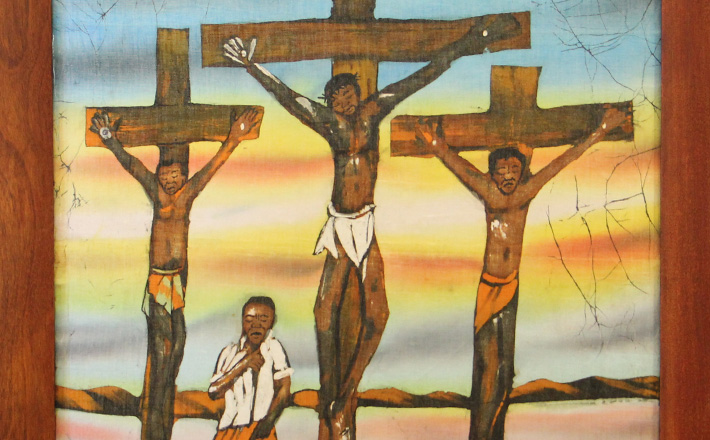Commentary on Hebrews 10:16-25
We Christians are an interesting, perhaps odd, group of people. We follow a savior who was born in a stable rather than a palace. A teacher who ate with tax collectors and sinners, who touched the untouchables, and called on us to do the same. And today we call Good Friday? How can we call this a good day? On this day we retell the story of our savior’s death in dishonor, surrounded by thieves. What can possibly be good about the day when we remember the torture and death of the Word made flesh who came to dwell among us so that we might have eternal life? This would seem to be a day of weakness and failure.
Over the past two years it has been difficult to call anything good. The person who wrote what we have entitled, “The Letter to the Hebrews,” seeks to show us why it was and still is a good day. And, during the continuing pandemic we, albeit odd Christians, are able to call life good. I appreciate how, in his New Interpreter’s Bible Commentary, Fred Craddock describes the unknown author as a preacher, for this is more a sermon than a letter.
Written by whom and for whom, we don’t know. We do know that the author drew extensively on the Hebrew Bible, hence the attribution. Today’s reading opens with the reminder from Jeremiah that God had heard the cries of the people. The prophet told the people in exile that God was going to give them a “new covenant” in their hearts and minds (Jeremiah 31:33-34). What makes this a good day, according to the author of this “sermon”, is that this new covenant, through the death of Jesus on the cross, has come to pass. The author’s goal is to explain how we are to understand who Jesus was and what he did.
The sermon/letter opens with the reminder that God told us who Jesus was, “You are my Son; today I have begotten you” (Hebrews 1:5l; Psalms 2:7; Mark 1:11). The writer continues, echoing the high Christology of John, “In the beginning, Lord, you founded the earth, and the heavens are the work of your hands” (Hebrews 1:10; Psalms 102:25; John 1:3a). The word came and dwelt among us and has accomplished his work as a high priest, “to make a sacrifice of atonement for the sins of the people” (Hebrews 2:17).
While Jesus gave us ways to understand who he was and what he was doing for us: the good shepherd, the true vine, the bread of life; the author of this sermon/epistle turned to the image of Jesus as our high priest. In verse 18, the writer continues a discussion that has been developing throughout the text, connecting the ministry of Jesus and his death with the priesthood and the sacrifices in the Temple.
If one was familiar with the priestly orders and sacrifices, which these readers seem to have been, one would know that Jesus could not be a high priest. He was, we have been reminded, “the son of David, and son of Abraham” (Matthew 1:1). Jesus was not a Levite, and the priests were drawn only from the Levites. Twice a year they were chosen to serve in the Temple performing the daily sacrifices for the sins of the people. They alone were able to enter behind the curtain into the Holy of Holies.
On this day we call “good,” we have a high priest who has offered the final sacrifice for the forgiveness of our sins. There will no longer be any need for the daily sacrifices because of what Jesus has done. We are told, “there is no longer any offering for sin” (Hebrews 10:18).
All has changed. Not only is there no need for sacrifices, but there is also no longer a need for human Levite priests. Jesus, our great high priest, has opened the curtain in the Temple so we all “have confidence to enter the sanctuary by the blood of Jesus” (Hebrews 10:19). In the synoptic gospels we hear that, at the death of Jesus, “the curtain of the temple was torn in two, from top to bottom” (Mark 15:38). Therefore, we now can call ourselves the “priesthood of all believers.”
This is a very good day. But our responsibilities to God and one another did not end because of Jesus’ death on the cross. The preacher not only explains what Jesus did on that good day but reminds us not only to remember what happened in the past; we are to look to the present and future. We are to turn our saved hearts and minds to the ways that we are to live this life in the new covenant. The author shows us what the life of these “odd” Christians is supposed to look like with three instructions echoing 1 Corinthians 13: “faith hope, and love”.
How are we to worship, entering the sanctuary, the Holy of Holies? It is with faith and “true hearts” that have been washed clean. With allusions to baptism, not only has the death of Jesus on the cross written God’s laws on our hearts and we are therefore “sprinkled clean from an evil conscience” (Hebrews 10:22), our whole bodies are “washed with pure water.” With hope we confess our faith in the God who has given us new life through the death of our savior on the cross. We are faithful because “he who has promised is faithful” (Hebrews 10:23).
And finally, we are to recognize that we are not alone in our worship and confessions. We are bound together in love. It is through this love that we uphold and encourage one another in these challenging times. If we see those who are coming before God in worship, failing to confess their love of God, we have been called to remind them that it was a Good Friday. It was a good day because our great high priest offered the final sacrifice of himself so that we would be able to declare that nothing “will be able to separate us from the love of God” (Romans 8:39).


April 15, 2022